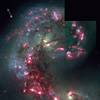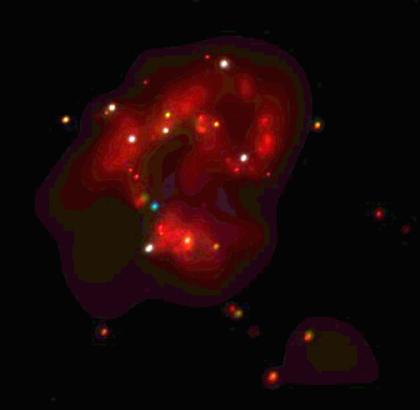Chandra Finds Abundance of Ultraluminous X-ray Sources
This Chandra X-ray image shows the central regions of two colliding galaxies known collectively as "The Antennae." The latest Chandra data reveal a large population of extremely bright X-ray sources in this area of intense star formation. These "ultraluminous" X-ray sources, which emit 10 to several hundred times more X-ray power than similar sources in our own Galaxy, are believed to be either massive black holes, or black holes that are beaming their energy toward Earth. In this X-ray image, red represents the low energy band, green intermediate and blue the highest observed energies. The white and yellow sources are those that emit significant amounts of both low- and high-energy X-rays.
The Antennae Galaxies, about 60 million light years from Earth in the constellation Corvus, got their nickname from the wispy antennae-like streams of gas seen by optical telescopes. These wisps are believed to have been produced by the collision between the galaxies that began about 100 million years ago and is still occurring.
|
||||||||||||||||||||||||||
This is an astronomical image from the Chandra X-ray Observatory, which features two colliding galaxies known as the Antennae (NGC 4038/4039). The dominant colors in the image are red and black. The image appears to have a slightly crescent-like circular shape, with many small dots of bright light scattered around it. The key structures in this image are the central areas of the two colliding galaxies. These galaxies appear to be merging into each other. The latest Chandra data reveal a large population of extremely bright X-ray sources in this area of intense star formation. These "ultraluminous" X-ray sources, which emit 10 to several hundred times more X-ray power than similar sources in our own Galaxy, are believed to be either massive black holes, or black holes that are beaming their energy toward Earth. In the X-ray image, red represents the low energy band, green intermediate and blue the highest observed energies. The white and yellow sources are those that emit significant amounts of both low- and high-energy X-rays. The Antennae Galaxies, about 60 million light years from Earth in the constellation Corvus, got their nickname from the wispy antennae-like streams of gas seen by optical telescopes of a larger field of view. These wisps are believed to have been produced by the collision between the galaxies that began about 100 million years ago and is still occurring.





